Best Blogging Platforms and Sites to Consider in 2025
By Alex Carter on October 10, 2024
Choosing a blogging platform depends on ease of use, customization, cost, and monetization options. Some platforms are beginner-friendly, while others offer more control over design and features. Below is a comparison of the top blogging platforms, highlighting their key features, drawbacks, and pricing.
What is a Blogging Platform?
A blogging platform is a tool that helps people create and manage blogs. It lets users write and publish blog posts that can include text, pictures, videos, or a mix of these.
Some platforms go beyond just blogging. They allow users to build full websites with custom domain names, making it easier to create a strong brand and even make money from the site. These platforms offer more control and customization, but they can take time to learn.
Others are designed to be simple and easy to use. They don’t require much technical knowledge, but they also have fewer customization options, meaning users have less control over how their blog looks and functions.
Factors to Consider When Choosing a Blogging Platform
When picking a blogging platform, think about ease of use, customization, cost, and ways to make money. Some platforms are simple, while others offer more flexibility—choose one that fits your blog’s needs.
Control and Customization
Some platforms allow full customization, including control over technical aspects and user experience. These options provide flexibility but require a learning curve. Others focus on simplicity, handling basic functions automatically, which limits customization but is more beginner-friendly. To keep websites functional and error-free, broken link checker tools help identify and fix broken links efficiently.
Ease of Use
Platforms vary in complexity. Some are designed for users who only want to write and publish content without dealing with technical details. Others offer more control but require familiarity with coding and platform management. The right choice depends on whether customization or simplicity is the priority.
Monetization
A blogging platform should support the intended monetization strategy. Common revenue options include:
- Subscription or membership models;
- Selling digital products like ebooks or courses;
- Affiliate marketing;
- Blog advertising.
Not all platforms accommodate every monetization method, so compatibility should be verified before making a decision.
Cost Considerations
Some platforms are free, while others require payments for various features, including:
- Domain registration;
- Hosting services;
- Platform fees;
- Design themes;
- Plugins or apps.
Certain platforms offer bundled pricing with a fixed monthly fee, while others charge separately for additional features. A lower-cost option may be suitable initially, but scalability should be considered if future expansion is expected.
15 Best Blog Sites and Platforms
WordPress.org

WordPress.org is a free, open-source platform that powers over 43% of all websites. It is a self-hosted solution, meaning users must sign up with a hosting provider. The platform offers full control over customization, making it a strong choice for bloggers, businesses, and content creators.
Pros
- Highly Scalable – Supports various functionalities, including forums, eCommerce, and membership sites;
- Extensive Customization – Thousands of free themes and plugins enable full control over design and features;
- SEO-Friendly – Built-in SEO tools and plugins help optimize content for search engines;
- Analytics Integration – Easily connects with Google Analytics for detailed performance insights;
- Multimedia Support – Drag-and-drop editor simplifies embedding videos, charts, and social media feeds.
Cons
- Learning Curve – Initial setup and navigation may require some technical familiarity;
- Self-Managed – Requires users to handle backups, security, and updates.
Pricing
The WordPress software is free, but additional costs include:
- Domain Name – Around $14.99/year;
- Hosting – Starts from $7.99/month.
WordPress.org offers full control over a blog’s design and features, allowing users to customize their site with themes, plugins, and advanced settings. Unlike WordPress.com, it provides complete ownership and flexibility, supporting various ways to earn money, such as ads, affiliate marketing, online courses, and memberships. Users can also enhance their site with plugins for contact forms, image galleries, and more.
While it requires managing security and backups manually, WordPress.org is a top choice for bloggers who want scalability, customization, and long-term growth.
Medium
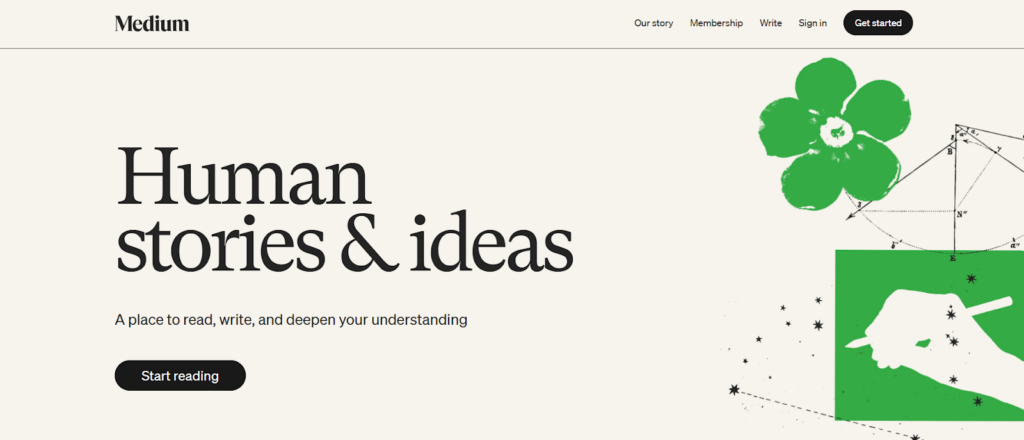
Medium is a user-friendly blogging platform that functions like a social network for writers and readers. It provides built-in monetization options and an established audience but has limited customization and SEO tools. It is best suited for writers who want to focus on content creation without dealing with technical setup.
Pros
- Easy to use – No setup required; no coding skills needed;
- Built-in audience – Content is discoverable by readers with similar interests;
- Writing-focused – No need to manage website design or technical aspects.
Cons
- Limited customization – Minimal design options and branding capabilities;
- No audience ownership – Losing the blog means losing all followers;
- No custom domain – Blogs exist under a Medium profile URL (e.g., medium.com/@yourname);
- Restricted monetization – Ads cannot be run; earnings are limited to the Medium Partner Program.
Pricing
- Free to use – Anyone can sign up and start writing;
- $5/month membership – Required to join the Partner Program and earn revenue. Membership also allows users to connect a custom domain to build their personal brand.
Signing up for Medium is simple with an email or social login. The homepage features published articles, staff picks, and recommended writers, making it easy to discover content and find inspiration. The platform’s interface feels like social media, allowing users to follow writers and engage with their work.
Writing on Medium is straightforward with a clean, distraction-free editor. Users can highlight text for formatting tools or use the plus (+) button to add images and links. However, customization is limited—writers can’t change blog design, layout, or branding, making it harder to stand out visually.
SEO tools are basic, offering only meta title and description edits. Advanced features like custom URLs and schema markup aren’t available. While Medium provides basic analytics, it lacks third-party integrations for deeper insights. Writers can earn through the Medium Partner Program, where payouts depend on reader engagement, averaging $10–$20 per 1,000 views.
Wix
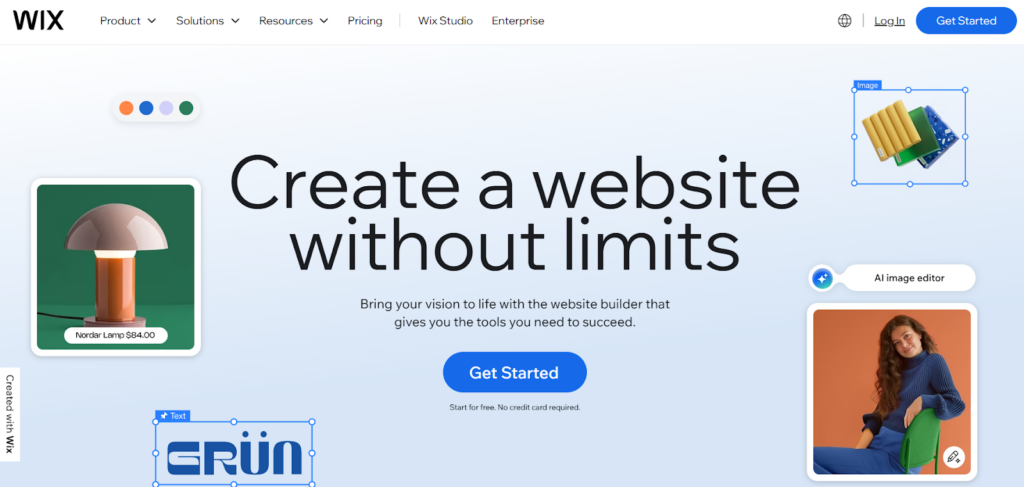
Wix is a blogging platform designed for businesses and individuals looking to scale their online presence. It offers an AI-powered website builder, built-in SEO tools, and multiple monetization options, making it suitable for both beginners and experienced users.
Pros
- Quick setup – AI-powered website builder generates a blog in minutes;
- Customizable design – Dozens of templates and advanced editing options;
- Built-in SEO tools – AI meta tag generator, manual SEO customization, and Semrush integration;
- Monetization options – Subscriptions, eCommerce, and dropshipping;
- Subscriber management – Automated emails and audience segmentation.
Cons
- Premium features require a paid plan – Free version has ads and limited functionality;
- Less flexibility than self-hosted platforms – Customization options are not as extensive as WordPress.
Pricing
Wix offers a free plan with limitations, while premium plans unlock advanced features.
- Free Plan ($0) – Limited features, includes Wix branding and ads;
- Light ($17/month) – Basic plan for small websites;
- Core ($29/month) – Adds eCommerce and marketing tools;
- Business ($36/month) – Ideal for business growth and brand expansion;
- Business Elite ($159/month) – Unlimited storage and scalability;
- Enterprise – Custom pricing for large-scale businesses.
Wix makes blogging easy with AI-powered tools that let users set up a site in minutes. You can either have the AI build a blog automatically or customize it using templates in the Wix Editor. It also offers AI-generated content ideas, writing assistance, and image creation tools, helping users create high-quality posts without technical skills.
The platform includes built-in SEO tools to boost search visibility. Users can generate AI-powered meta titles and descriptions or manually adjust SEO settings. Wix also integrates with Semrush, allowing for keyword research directly within the platform. For engagement, it offers subscriber management tools to send automated email updates and personalize content for different audiences.
Wix provides detailed analytics to track audience engagement and multiple ways to monetize content. Bloggers can offer subscriptions, sell products through eCommerce features, or earn from ads and sponsorships. Wix provides these tools to assist bloggers increase their following, improve their content, and generate revenue.
Tumblr
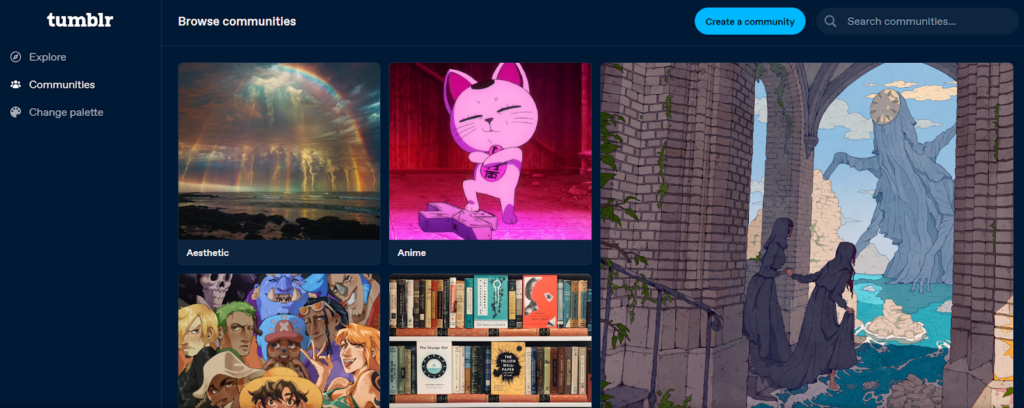
Tumblr is a free blogging platform known for its pop-culture content, GIFs, memes, and informal writing. It combines blogging with social media features like reblogging and tagging, allowing content to gain viral traction. While its user base is smaller than it once was, it remains highly engaged and community-driven.
Pros
- Easy to use – Simple setup with minimal technical requirements;
- Social media integration – Built-in reblogging and tagging features increase content visibility;
- Highly engaged audience – Niche communities offer strong interaction and engagement;
- Monetization options – Supports Tumblr Post+, reader tips, affiliate links, and ad partnerships.
Cons
- Limited customization – Fewer design and formatting options than traditional blogging platforms;
- Not the best for long-form writing—works better for visuals, memes, and short posts.
Pricing
Tumblr offers optional monetization features for content producers who want to make money from their blogs, but it is still totally free to use.
Tumblr is great for casual, creative content, making it ideal for writers who enjoy free-flowing storytelling or sharing visuals like GIFs, memes, and photos. It has a dedicated community that thrives on interaction, with engagement at its core. The reblogging feature works like a retweet, helping posts spread quickly, while the tagging system makes it easier for users to find content on specific topics.
Tumblr gives authors several options to make money, such as:
- Tumblr Post+ – A subscription-based model for exclusive content;
- Reader tips – Direct contributions from followers;
- Affiliate marketing – Sharing links to earn commissions;
- Ad partnerships – Integrating ads into blog content.
Tumblr is great for creatives and visual storytellers who want a social, interactive space for short-form content. It’s less ideal for those needing deep customization or a focus on long-form writing.
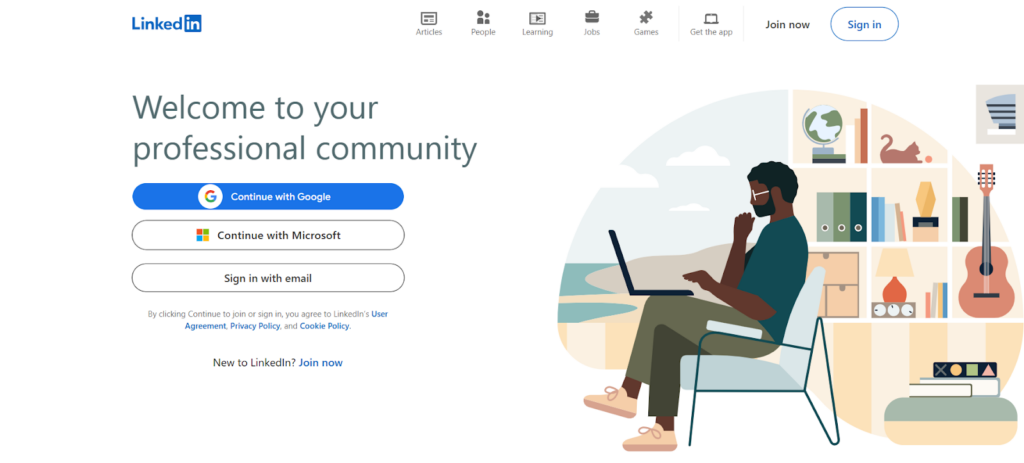
LinkedIn is a blogging and networking platform designed for professionals to share insights, industry trends, and thought leadership. The article publishing feature helps users establish credibility, engage with their network, and enhance their professional reputation.
Pros
- Built-in professional audience – Articles reach industry peers and potential collaborators;
- SEO and discovery tools – Hashtags and metadata improve visibility;
- Comment management – Users can enable or disable comments for controlled discussions;
- Profile integration – Articles are linked to user profiles, boosting credibility.
Cons
- Limited design and formatting tools – Not ideal for visual branding or multimedia-heavy content;
- Content is platform-dependent – Articles remain on LinkedIn, reducing flexibility for cross-platform use.
Pricing
LinkedIn’s article publishing feature is completely free, making it an accessible tool for professionals looking to share expertise and expand their industry presence.
LinkedIn articles benefit from SEO features, including hashtags and metadata, making them easier to discover. Articles are linked directly to user profiles, helping professionals showcase expertise, attract potential employers, and build industry connections. Users can also manage engagement by choosing whether to enable or disable comments, ensuring discussions align with their goals. Unlike traditional blogging platforms, LinkedIn is best suited for professional insights, industry updates, and business-related discussions. It is an effective tool for personal branding but lacks advanced design features for visual content creators.
LinkedIn is the best platform for professionals, company executives, and industry specialists who want to post thought-provoking articles and establish connections with other professionals. Bloggers who specialize in multimedia or design-heavy material are less likely to find it useful.
Ghost
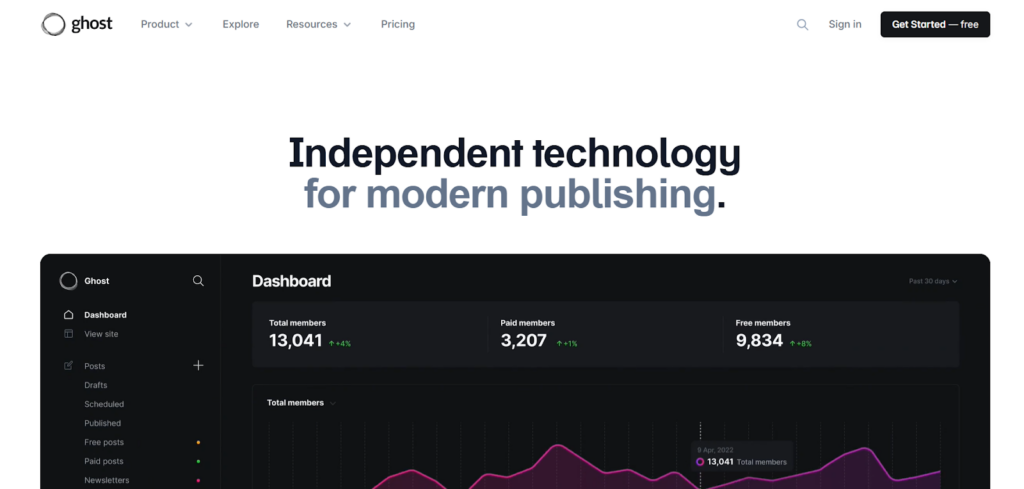
Ghost is a lightweight, open-source blogging platform designed for content creators, influencers, and writers looking to monetize their audience. It offers built-in tools for subscriptions, newsletters, and analytics, making it a strong alternative to Patreon but focused on written content.
Pros
- Built-in membership and newsletter features – Ideal for content monetization;
- SEO-friendly – Comes with integrated SEO tools for content optimization;
- Lightweight platform – Uses integrations instead of plugins, reducing overhead.
Cons
- Open-source version is not beginner-friendly – Requires manual setup and hosting;
- Advanced customization needs coding skills – Limited drag-and-drop options;
- Smaller community – Fewer third-party resources compared to larger platforms.
Pricing
Ghost offers multiple subscription options:
- Starter – $9/month (1 admin, 500 members);
- Creator – $25/month (2 admins, 1,000 members);
- Team – $50/month (5 admins, 1,000 members);
- Business – $199/month (Unlimited admins, 10,000 members).
Ghost lets content creators earn money through subscriptions, offering tiered memberships for premium content. This allows for a steady income without depending on social media algorithms.
It also includes marketing tools like strategic CTAs and newsletter segmentation to boost engagement and grow subscriber lists. Built-in analytics help track reader behavior, making it easier to refine content strategies.
Ghost is ideal for independent writers and creators who want full control over their monetization and don’t mind a slightly technical setup.
Hostinger Blog Maker
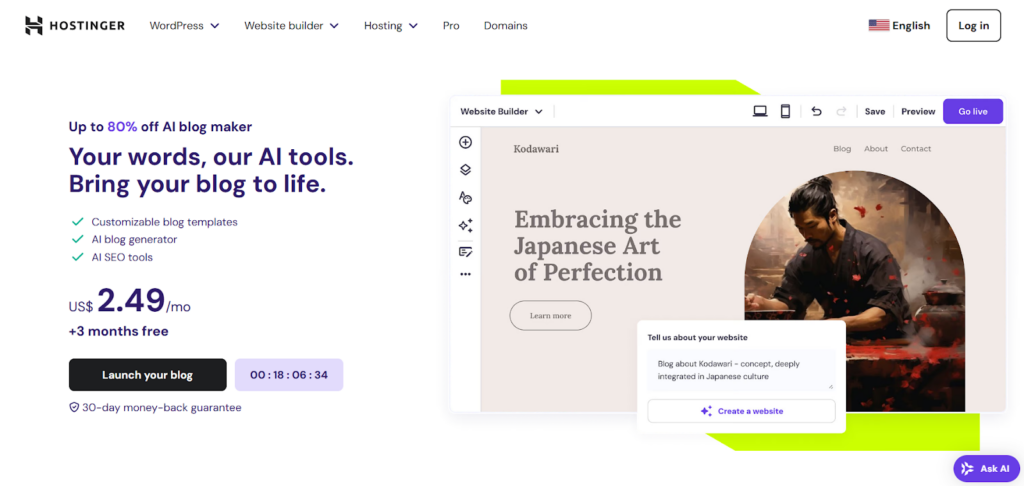
Hostinger Blog Maker is a user-friendly website builder that helps create blogs, business sites, portfolios, and online stores with AI-powered tools. It features drag-and-drop editing, eCommerce support, and built-in tools to simplify the website-building process.
Pros
- AI-powered website builder – Creates a fully functional site in minutes;
- Easy customization – Drag-and-drop editor for layout and content adjustments;
- eCommerce support – No additional transaction fees and 20+ payment gateways;
- SEO tools included – Helps improve search engine rankings.
Cons
- Limited third-party integrations – Unlike WordPress.org, lacks plugin support;
- Difficult to switch templates – Changing designs after setup is not straightforward;
- No free plan – Requires a paid subscription, though it includes a 30-day money-back guarantee.
Pricing
- Premium Plan – $2.69/month (AI website creation, eCommerce support, free domain & email);
- Business Plan – $3.59/month (Advanced features and higher resource limits).
Hostinger simplifies website and blog creation through AI automation. Users answer a few questions, and the AI generates a fully functional website with customizable text and images. The drag-and-drop editor makes it easy to format content, add new elements, and create additional pages. For businesses and bloggers looking to sell products or services, Hostinger includes eCommerce functionality, supporting multiple payment gateways without extra fees.
Hostinger is a great option for beginners, small businesses, and bloggers looking for an AI-powered, user-friendly blogging solution with affordable pricing and built-in SEO tools. However, those needing extensive third-party integrations may find self-hosted platforms like WordPress.org more suitable.
Drupal
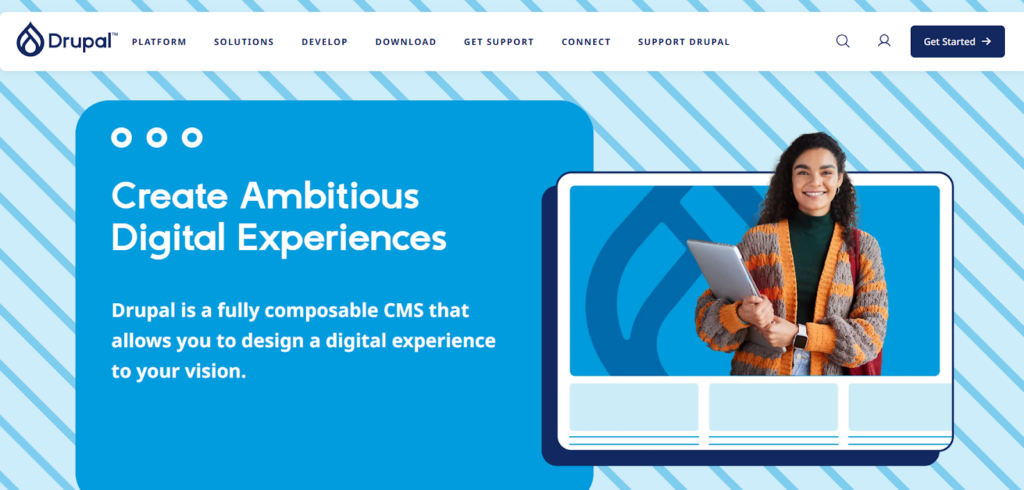
Drupal is an open-source Content Management System (CMS) designed for businesses that require customization and scalability. It features a WYSIWYG (What You See Is What You Get) editor, making content creation more accessible while offering advanced development capabilities for technical teams.
Pros
- Flexible and customizable – Ideal for enterprises with specific requirements;
- User-friendly editor – Content appears as it will be published;
- Audience targeting and accessibility – Supports personalized content and inclusive design;
- Multilingual support – Available in 100 native languages.
Cons
- Requires technical expertise – Best suited for users with development experience;
- Steep learning curve – Not as intuitive as beginner-friendly website builders.
Pricing
Drupal is completely free to use, but development, hosting, and maintenance costs depend on business requirements and setup complexity.
Drupal’s open-source nature means businesses have full control over their website, unlike proprietary platforms that impose restrictions. This flexibility is why large enterprises like Nokia, NASA, and Charles Schwab use Drupal to develop custom blogs and websites tailored to their needs.
The WYSIWYG editor allows content teams to see and edit content exactly as it will appear upon publication, ensuring a smooth workflow for non-technical users. Additionally, Drupal offers audience-targeting features, allowing businesses to deliver personalized content based on user behavior.
Drupal is best suited for enterprises, developers, and organizations that require highly customizable and scalable website solutions. It is not ideal for beginners due to its technical complexity.
HubSpot CMS
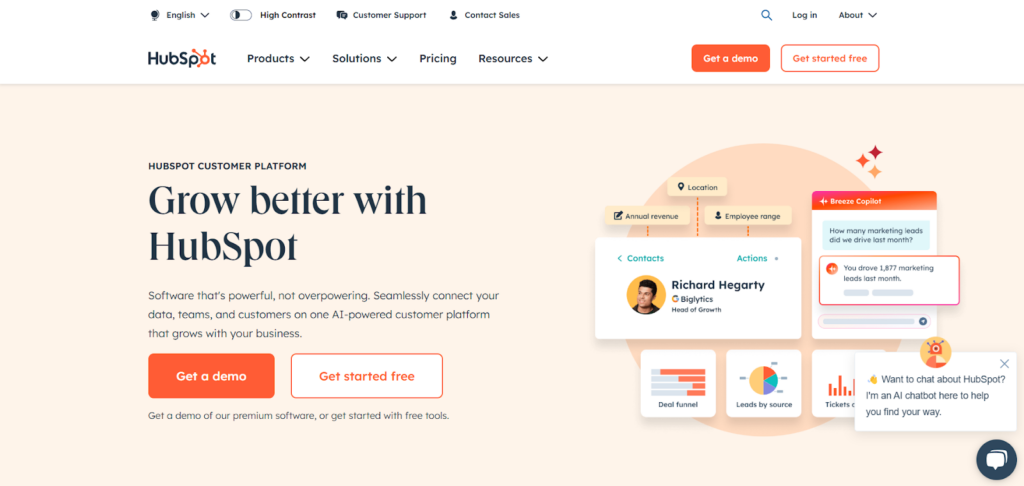
HubSpot CMS is a fully integrated content management system designed for businesses of all sizes. It connects effortlessly with HubSpot’s marketing and CRM tools, allowing users to create a website, manage customer lists, send newsletters, and optimize content for conversions from a single platform.
Pros
- Drag-and-drop website builder – No coding skills required;
- Quick setup and hosting included – No need for external hosting services;
- SEO and conversion optimization – Built-in tools to improve search rankings;
- Free SSL certificate – Ensures website security.
Cons
- No free version – While HubSpot CRM offers free tools, the CMS requires a paid subscription;
- Higher pricing for advanced features – Costs increase with additional capabilities;
- Migration process can be complex – Moving from another blogging platform may take time.
Pricing
- CMS Starter Plan – $25/month (Includes core features for building and optimizing a blog);
- Advanced Tiers – Higher plans unlock custom SEO recommendations and advanced marketing tools.
HubSpot CMS helps with content creation, audience engagement, and marketing automation. Users can customize website layouts, create personalized content based on visitor behavior, and use built-in analytics to track performance.
Since HubSpot hosts the website, users don’t need to worry about external hosting providers. The platform also offers custom SEO recommendations, helping users optimize their blogs for search engines and improve conversions.
HubSpot CMS is ideal for businesses, marketers, and entrepreneurs looking for a blogging platform with integrated CRM and marketing automation tools. It may not be the best option for budget-conscious users or those needing a free CMS solution.
Blogger
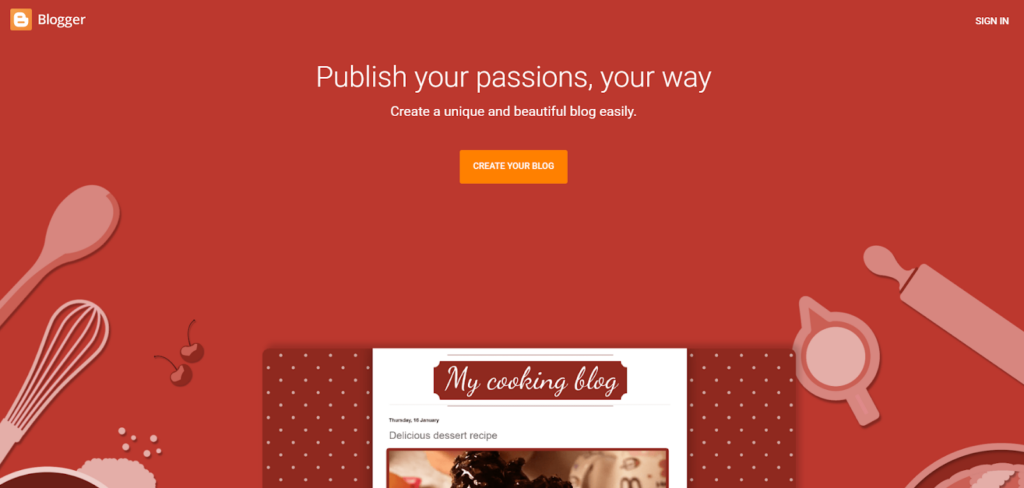
Blogger is a simple, free blogging platform created by Google. It offers an easy-to-use interface, customizable templates, and smooth integration with Google services. This makes it a great choice for beginners and those starting a tech-focused blog.
Pros
- Completely free – No cost to start or maintain a blog;
- Beginner-friendly – Simple setup and management with no technical skills required;
- Google-backed security and reliability – Runs on Google’s stable and secure infrastructure.
Cons
- Limited features – Basic blogging tools with no option to expand functionality;
- Restricted design options – Fewer templates, and many third-party templates lack quality;
- Infrequent updates – Lacks regular improvements or new features;
- Platform dependency – Google can suspend blogs or discontinue the service at any time.
Pricing
Blogger is completely free to use, with optional monetization through Google AdSense.
Since Blogger is part of Google’s services, users benefit from its robust security features and smooth integrations. It allows bloggers to enhance visual content with Google Photos, track performance using Google Analytics, and monetize their blogs effortlessly through Google AdSense.
The platform is beginner-friendly, with customizable templates that make it easy to design a blog. Additionally, Blogger has an active user community and a wealth of online resources, making it easy for new bloggers to find support and guidance.
Blogger is ideal for beginners, hobby bloggers, and those looking for a free, no-frills blogging platform. However, it may not be suitable for users who require advanced customization, SEO tools, or scalability.
btw
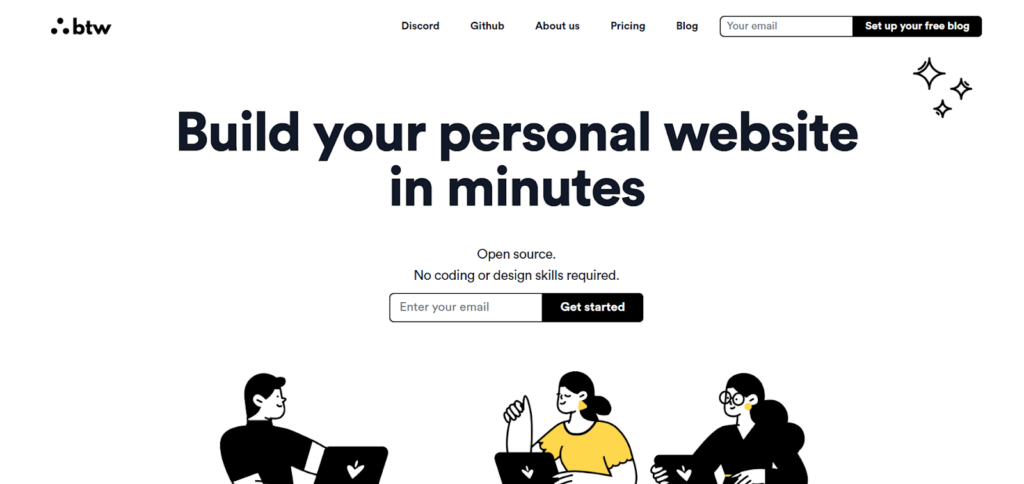
btw is a lightweight, open-source blogging platform designed for simplicity. It features a built-in writing assistant that helps improve readability, making it a great choice for minimalist bloggers and developers looking for a customizable alternative to mainstream platforms.
Pros
- Built-in writing assistant – Highlights readability issues and suggests improvements;
- Free plan without ads – No intrusive branding on blog posts;
- Open-source and customizable – Can be self-hosted and modified to fit specific needs.
Cons
- Limited updates – Still in early development, so new features roll out slowly;
- Basic blogging capabilities – Lacks advanced customization and extra features;
- No built-in monetization tools – Users must rely on third-party solutions.
Pricing
- Free hosted version – No ads, with a premium plan for custom domains coming soon;
- Self-hosted version – Cost depends on web hosting or local setup.
btw was created by developers who prioritize writing clarity, inspired by the Hemingway App. The post editor provides real-time feedback on readability, eliminating the need to switch between external editing tools. However, btw lacks extensive customization options. It focuses on simple, text-based blogging, making it ideal for those who need a distraction-free writing experience.
btw is best suited for writers who want a clean, ad-free blogging platform and developers looking for an open-source alternative with customization potential. It’s not ideal for users who need advanced features, monetization tools, or a highly customizable blog layout.
Substack
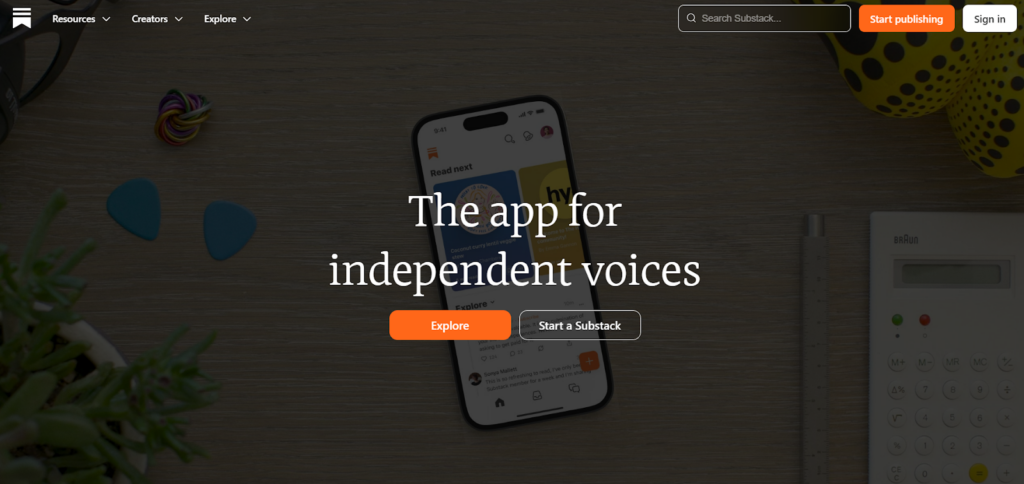
Substack is a blogging and newsletter platform that allows writers to publish content and send posts directly to subscribers’ inboxes. It also offers monetization options through paywalled content, making it a strong choice for independent writers and journalists.
Pros
- Mobile-friendly – Available as an app for easy access;
- Writer collaboration – Features cross-posting to expand reach;
- Built-in podcast and chat support – Enables multi-format content creation.
Cons
- High commission fees – Takes 10% of subscription revenue, plus Stripe processing fees;
- Limited email marketing tools – Lacks advanced automation features;
- Low email deliverability – Some newsletters may land in spam folders.
Pricing
- Free to use – No cost for publishing or maintaining a blog;
- Monetization fees – Substack takes 10% of paid subscriptions, plus Stripe fees (2.9% + $0.30 per transaction and 0.7% for recurring payments);
- Custom domain setup – One-time $50 fee, plus domain registration costs.
Substack functions like a hybrid between Medium and Patreon, allowing writers to publish blog posts while monetizing exclusive content. It supports importing email lists from services like Mailchimp, Ghost, and Patreon, making migration easy for existing content creators. The post editor is minimalistic and supports various content formats, including poetry, financial charts, and long-form articles. Users can embed subscription buttons, sharing links, and comment sections to boost engagement.
For SEO optimization, Substack allows custom metadata and URLs, though customization options remain limited. Additionally, its social preview feature helps enhance visibility when sharing posts on social media.
One major drawback is email deliverability. Due to shared IP addresses, some newsletters end up in spam folders unless users connect a custom domain. Branding customization is also minimal, with restricted layout and design options.
Substack is ideal for writers, journalists, and content creators looking for an email-driven blogging platform with built-in monetization tools. However, those seeking advanced email marketing, customization, or lower commission fees may prefer other platforms like Ghost or WordPress.
Web.com
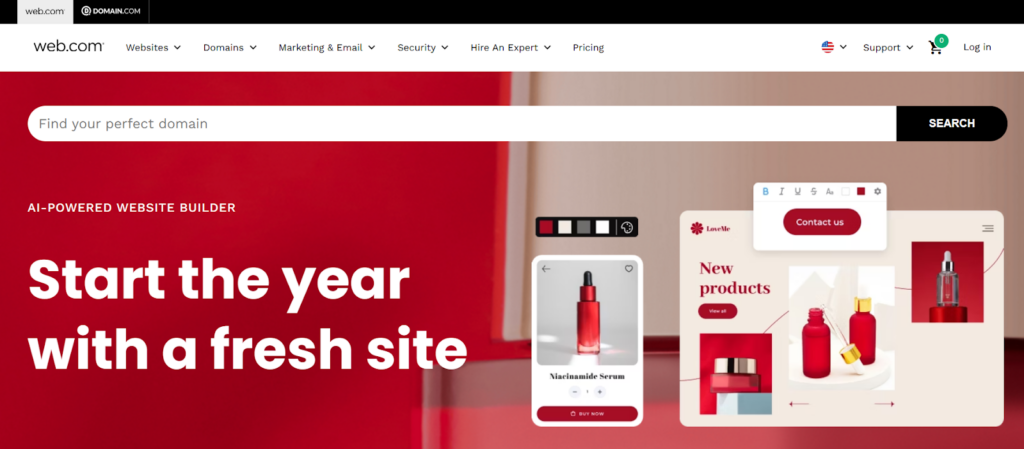
Web.com is a drag-and-drop website builder designed for small businesses, entrepreneurs, and online stores. It includes an easy-to-use blogging feature, making it a good option for those who want to add a blog to their business website without dealing with coding or complex setup.
Pros
- Beginner-friendly editor – No coding required;
- Customizable templates – Dozens of pre-made designs for blogs;
- Easy setup – Hosting and technical details managed by Web.com;
- Affordable starting price – Plans begin at $1.95 per month;
- Free domain included – All paid plans come with a free domain;
- 24/7 customer support – Available via phone, live chat, and email.
Cons
- Limited third-party integrations – Fewer plugin options compared to WordPress;
- Basic blogging features – Not as robust as dedicated blogging platforms;
- Difficult to migrate – Switching to another platform later can be challenging.
Pricing
- Starter Plan – $1.95/month (Drag-and-drop builder, blogging, free domain);
- Marketing Plan – $7.95/month (Includes SEO tools);
- eCommerce Plan – $13.95/month (For online stores).
Web.com provides an all-in-one website and blog-building experience, handling hosting, security, and design for users. The platform offers SEO tools, autosave & backup features, and website analytics, making it a simple yet effective solution for small business owners.
Users can choose from hundreds of templates and customize their blog layout without writing code. While it does not offer as many advanced blogging tools as WordPress, it remains a cost-effective choice for those seeking a hassle-free blogging experience.
Web.com is best for small businesses, entrepreneurs, and non-technical users who want a simple website with a built-in blog. However, those looking for extensive blogging tools and flexibility may prefer WordPress or other open-source platforms.
Weebly

Weebly is a popular website builder owned by Square, offering simple tools for creating business websites and online stores. It also includes a blogging feature with free templates that can be added to any site.
Pros
- Fully hosted, so no setup is needed;
- Integrates smoothly with Square for payments;
- Easy to use for beginners.
Cons
- The free plan has limited features, bandwidth, and Weebly branding;
- Paid plans are pricier compared to top blogging platforms;
- Blogging and SEO tools aren’t as advanced as WordPress.
Pricing
Weebly offers a free plan with ads and branding. Paid plans start at $10/month (billed annually), with the Professional plan at $12/month and the Performance plan at $26/month.
Squarespace

Squarespace is a drag-and-drop website-building service known for its professionally designed templates and simple interface. It is designed for small business owners, creatives, and individuals who want to build a visually appealing website without needing technical expertise.
Pros
- Beginner-friendly – No coding required;
- High-quality templates – Modern, professionally designed themes;
- Includes domain and SSL – Secure website hosting included;
- eCommerce support – Available for online stores.
Cons
- Limited customization – Features are restricted to the built-in platform;
- Fewer integrations – Only supports select third-party tools;
- Higher pricing – More expensive compared to some alternatives.
Pricing
- Personal Plan – $23/month ($16/month when paid annually);
- Business Plan – $33/month ($23/month when paid annually);
- Online Store Plans – Start at $27/month, up to $49/month for advanced features.
Squarespace was founded in 2003 and now powers millions of websites. It offers a sleek, easy-to-use design experience, making it ideal for personal websites, portfolios, and small businesses.
The platform provides custom domains, SSL security, and eCommerce features, allowing users to sell products or services online. However, because Squarespace operates as a proprietary system, customization and third-party integrations are more limited compared to platforms like WordPress.
Squarespace is best for small business owners, creatives, and individuals looking for a visually appealing website with an intuitive builder. However, users who require extensive third-party integrations or full design flexibility may find other platforms like WordPress more suitable.
Conclusion
Selecting a blogging platform depends on customization, ease of use, monetization, and cost. Some options offer full control, while others focus on simplicity. Business-oriented platforms provide additional tools, while free options suit casual writers. Comparing features and costs helps in making the right choice for content goals and future growth.
Posted in blog, Web Applications
Alex Carter
Alex Carter is a cybersecurity enthusiast and tech writer with a passion for online privacy, website performance, and digital security. With years of experience in web monitoring and threat prevention, Alex simplifies complex topics to help businesses and developers safeguard their online presence. When not exploring the latest in cybersecurity, Alex enjoys testing new tech tools and sharing insights on best practices for a secure web.
